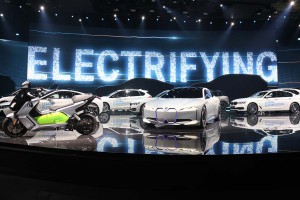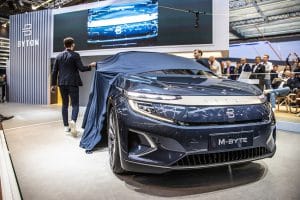
BMW’s Frankfurt stand in 2017 covered about 37,000 square foot. It was downsized significantly last year.
Stretching for nearly a mile from one end to the other, the Frankfurt Messe, the city’s convention center complex, is one massive affair. And, yet, for decades the auto industry filled up almost every inch of the complex, even setting up additional, temporary display space for the biennial Frankfurt Motor Show.
But after a sudden chill this past autumn, the group that has organized the show is calling it quits. There will be no show in Frankfurt in 2021, raising still more questions about the future of auto shows in general.
In a statement that didn’t come as a complete surprise, the Verband der Automobilindustrie, the organizing body, thanked the City of Frankfurt for “this long, very good and trusting partnership.” Considering Germany’s role in the auto industry, the VDA says it is looking at “very creative” ideas offered up by other cities, including Berlin, Hamburg and Munich. But, considering the way things are going for auto shows, few would be surprised if 2019 marks the country’s last major event.
(Frankfurt plugs in. Automakers hope to charge up buyers with new EVs debuting at show)
It certainly didn’t help that an array of automakers, including Toyota, Renault, Peugeot, Nissan, Fiat and Ferrari skipped the most recent show — officially known as the Internationale Automobil-Ausstellung, or IAA. Others, including Germany’s own industry giants, such as Mercedes-Benz and BMW, sharply cut back on their own presence.

Byton looks like its ready to jump into the ever-expanding electric vehicle fray with its M-Byte at the 2019 Frankfurt Motor Show.
Complicating matters, public attendance all but collapsed. At 550,000 paid visitors, it posted a 31% decline from the prior show in 2017, down from a much healthier 931,000 in 2015.
The fact that traditionally car-crazed Germans have shown less and less interest in such an event doesn’t necessarily bode well for the auto industry, as a whole. But it’s of more immediate concern for car shows, in particular.
Consider what happened in 2018 at the Paris Motor Show which has traditionally alternated with Frankfurt in an odd/even sequence. A long list of brands – including Ford, Infiniti, Lincoln, Mazda, Mitsubishi, Nissan, Opel, Subaru, the Volkswagen brand and Volvo – were no shows. The City of Lights traditionally hosted a packed, two-day schedule of media previews. Instead, the single-day roster began late and ended at lunchtime.
There’s been no indication that Paris will be the next to quit, but it certainly won’t help its future if the industry doesn’t come through with strong support when the event is scheduled to return later this year.
The same could be the case for Geneva, where the industry hosts an annual bacchanal marking the end of winter. Scheduled to run from March 5 through 15, the Swiss event draws visitors from all over Europe – and beyond. It also benefits from the national sense of neutrality, in contrast to the Paris and Frankfurt shows that emphasize local manufacturers. There are a number of automakers already confirming specific debuts in Geneva this year, but the pullouts have also begun, Lamborghini and Peugeot among traditional players who won’t participate this time.
Europe isn’t the only place where auto shows are getting hammered. The Tokyo Motor Show, which takes place in odd years, is a shell of its former self, earlier this decade moving from the massive Makuhari convention complex near Narita Airport into a comparatively tiny building closer to downtown.
Tokyo’s downfall is, in part, due to the peculiar nature of its automotive market, foreign manufacturers never able to gain any real traction. The show is little more than a showcase of what local makers, Toyota, Nissan and Honda, in particular, have in store.
That may have led folks to misread the tea leaves and not recognize that auto shows, in general, are in trouble.
That’s becoming readily apparent in the U.S. market, especially when it comes to the four true newsmaking events in Detroit, Chicago, New York and Los Angeles – in that annual sequence.
(Detroit Auto Show moving to June in 2020, adding major new features)
The Motor City event, formally known as the North American International Auto Show, or NAIAS, is this year in major transition, switching from its traditional January date to June. There are any number of reasons why — though, surprisingly, Detroit’s typically miserable winters had little to do with the decision.
While public attendance was far more stable than in Frankfurt, the decline in the manufacturer count bordered on catastrophic over recent years. Of the German brands, only VW was on hand in January 2019 and even its sibling Audi, Bentley and Lamborghini marques were among the many no-shows. In turn, what once was a three-day media extravaganza that, at its peak, saw 71 major new model debuts, ran little longer than the Paris preview, with barely a dozen significant introductions.
Detroit’s downfall underscores the variety of issues auto shows face. From a media preview perspective, NAIAS had to cope with the growing importance of CES, the big electronics show taking place in Las Vegas just days before. As cars increasingly become computers on wheels, many automakers shifted to CES to make news and get it more broadly covered.
Then there’s the basic issue of cost. Auto shows are wildly expensive to put on. Major shows typically charge a brand at least $1 million for a stand, and big displays have been known to top $5 million and up. A fancy news conference can add millions more. It’s become increasingly common for automakers to stage previews off-site to save money. And that’s encouraged them to debut products at standalone events.
Cadillac will debut the new Escalade in Los Angeles next week, a day before the media preview at the Chicago auto show. The Windy City once hosted the most significant media previews among North American auto shows. Today, it also struggles to fill a full day. The show has lost fewer automakers on the public-facing side, however, and still tends to draw over a million visitors, so it may be secure – for now.
The New York International Auto Show also tends to pack in consumers – and the city’s role as America’s media capital has traditionally ensured lots of product announcements. Yet, the Big Apple has had a big bite taken out of it, Audi, BMW and Mercedes-Benz already announcing they won’t show up for either the media or public events in April 2020. Others could follow.
Los Angeles has also seen its share of defections and organizers have to be worrying as they prepare for their own even next November.
Globally, only a handful of auto shows continue to show strength, most notably in China. That’s likely no surprise considering the country has become the world’s largest automotive market and a large share of motorists are first-time buyers likely to be dazzled by the glitz of an auto show. Meanwhile, the market is incredibly competitive. Foreign manufacturers, such as VW and GM, are struggling to hold off increasingly powerful local carmakers. And there are more and more of those each year ready to fill up space should someone pull out.
That said, the Chinese new car market, which had been growing at a strong double-digit rate for two decades, posted its first major downturn last year. Separately, a number of cities have put in place limits on car sales to cope with traffic congestion and air pollution. It’s too early to see if those factors could impact auto show turnout in places like Shanghai and Beijing.
Back in Germany, the VDA hopes to use some of the “creative ideas” it has been offered to revitalize the car show concept. In Motown, the Detroit Auto Dealers Association has already announced plenty of changes in store when NAIAS returns in June. That includes using outdoor space along the Detroit waterfront, as well as setting up opportunities for the public to drive some of the vehicles on display.
(Ford pulls out of Geneva Motor Show)
Some experts believe that in today’s digital world, more interactivity will be critical to saving the car show. Detroit could provide a signal of how such events might take shape. But with few of the brands that skipped out in 2019 set to come back, it’s far from certain the new approach will gain traction. And, as with the cancellation of the Frankfurt event, that would be bad news for auto shows everywhere.
